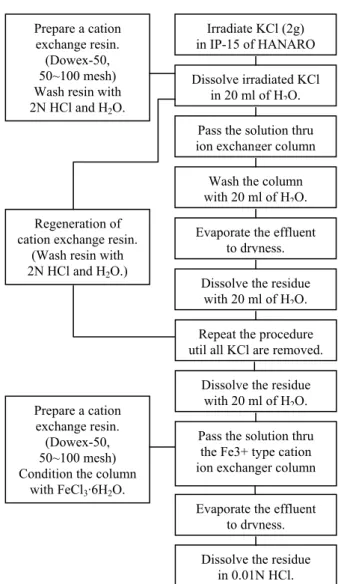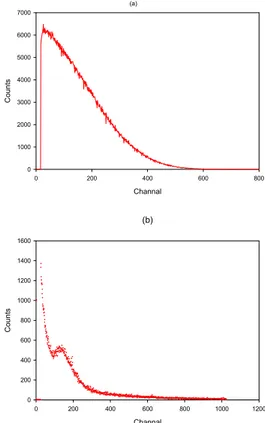Production of Sulfur-35 by the Cation Exchange Process
Ik Soo Kim, Seung Im Kwak, Ul Jae Park, Hong Sik Bang, Hyun Soo HanKorea Atomic Energy Research Institute 150 Dukjin-dong, Yuseong-gu, Daejeon, Korea 305-353
1. Introduction
Sulfur-35 is the most commonly used radioactive isotope of sulfur, and it is a cosmogenic isotope that has a half life of 87 days. The short half life of 35S allows it
to be used to examine the influence of recent (~1yr) precipitation. The presence, or subsequent absence, of
35S indicates the source of at least part of the water is
recent precipitation, and there is a flowpath which delivers this water to the sampled location. 35S is a
conservative tracer, and acts as sulfate as it flows through the system.
Sulfur-35 is usually produced by neutron irradiation on potassium chloride, utilizing the 35Cl(n,p)35S
reaction. Although the 34S(n, γ)35S reaction can also be
utilized, it produces a product of low specific activity and is not practical.
In this study, technique to produce carrier-free sulfur-35 from neutron irradiated potassium chloride was developed. For the post-irradiation process, the cation exchange method based on the selective adsorption of phosphate on Fe+3-cation exchange resin
was adopted.
2. Methods and Results
2.1 Cation Exchange Process
The simplest way of separating the 35S from
potassium chloride is by cation exchange resin. An aqueous solution of the irradiated potassium chloride is passed through a hydrogen form cation exchange resin to remove potassium. The effluent is evaporated to dryness to remove chlorine and 36Cl. The 35S is leached
by dilute hydrochloric acid. It is obtained directly in the form of sulfuric acid without any oxidation of the product.
The 35S produced by this procedure is adequately
pure except for minute quantities of 32P, which must be
separated when present in non-negligible amount. This is done by adsorption of the 32P in iron form cation
exchange resin.
2.2 Experimental Method
The 2g of KCl target was irradiated in a flux of 1.76 x 1012 n/cm2·s in IP-15 of HANARO for about 170
hours, which produced about 7 mCi of 35S. Sulfur-35
was separated from irradiated KCl by the cation exchange process shown in Figure 1. An exchange resin
column of 1 cm in diameter by 20 cm long filled with Dowex-50 of 50/100 mesh size was used to treat 25 cm3
of dissolved KCl.
Figure 1. The flow-sheet for the production of 35S by the
cation exchange process.
2.3 Results
The radioactivity of 35S produced was measured
using a liquid scintillation method. The measurements were performed using the Hidex model Triathler liquid scintillation counter.
The liquid scintillation samples were prepared from a solution of 35S in hydrochloric acid by gravimetrically
adding 35S solution into 20 ml low-potassium glass
Prepare a cation exchange resin. (Dowex-50, 50~100 mesh) Wash resin with 2N HCl and H2O.
Irradiate KCl (2g) in IP-15 of HANARO Dissolve irradiated KCl
in 20 ml of H2O.
Pass the solution thru ion exchanger column Wash the column with 20 ml of H2O.
Evaporate the effluent to dryness. Dissolve the residue
with 20 ml of H2O.
Repeat the procedure util all KCl are removed. Regeneration of
cation exchange resin. (Wash resin with 2N HCl and H2O.)
Dissolve the residue with 20 ml of H2O.
Pass the solution thru the Fe3+ type cation ion exchanger column Evaporate the effluent
to dryness. Dissolve the residue
in 0.01N HCl. Prepare a cation
exchange resin. (Dowex-50, 50~100 mesh) Condition the column
with FeCl3·6H2O.
Transactions of the Korean Nuclear Society Autumn Meeting Busan, Korea, October 27-28, 2005
vials containing 10 ml liquid scintillator. Liquid scintillator Aqualight from Hidex was used. The samples used for the measurement were prepared by deposition of known amounts, about 20 mg, into the scintillator. The masses were determined accurately by the pycnometer method. Pycnometer was weighed on a micro balance before and after the drops had been expelled. The samples were measured for 2 minutes. The spectrum for 35S obtained experimentally using
liquid scintillation counting is shown in Figure 2(a). Radionuclide purity was determined by Cerenkov counting and by gamma-spectrometry. The impurity
32P(E
max=1.71Mev) can be measured in the presence of 35S(E
max=0.166MeV) by Cerenkov counting, which has
been applied to beta-ray emitters with different maximum energies. As a result, it was confirmed that the impurity 32P did not exist.
The γ-radionuclidic impurities were measured by HPGe detector(Ametec_ortec). The spectrum shown in Figure 2(b) was recorded by multi-channel analyzer DSPec(Ametec_ortec) and Maestro-32 software. The volume of 1 ml of the diluted solution in a 20 ml glass vial was measured, but γ-radionuclidic impurities were not detected except environmental radioactivity. The amount of γ-impurities in the solution of 35S was not
exceed 0.0001%. Channal 0 200 400 600 800 C oun ts 0 1000 2000 3000 4000 5000 6000 7000 (a) (b) Channal 0 200 400 600 800 1000 1200 Count s 0 200 400 600 800 1000 1200 1400 1600
Figure 2. (a) The beta spectrum of 35S recorded in the triathler,
(b) gamma spectrum of 35S on HPGe detector
3. Conclusion
Procedure to produce sulfur-35 from neutron irradiated potassium chloride was developed. The cation exchange process which is based on the selective adsoptrion of phosphorous-32 on Fe3+-cation exchange
resin was adopted. Sulfur-35 has been produced by this process, and product of high quality has been obtained..
REFERENCES
[1] N. Shibata and E. Shikata,, Methods of Production of Phosphorus-32, Sulfur-35, and Iodine-131, JAERI-4027, 1963. [2] E. Shikata, et. al., Development of Techniques of Production of Sulfur-35 and its Inorganic Compounds, JAERI 1273, 1981.
[3] A. F. Rupp, Progress in Nuclear Energy, Series III, Process Chemistry, Vol.1, Pergamon Press, London, 1986. [4] Manual for Reactor Produced Radioisotopes, IAEA-TECDOC-1340, 2003.

